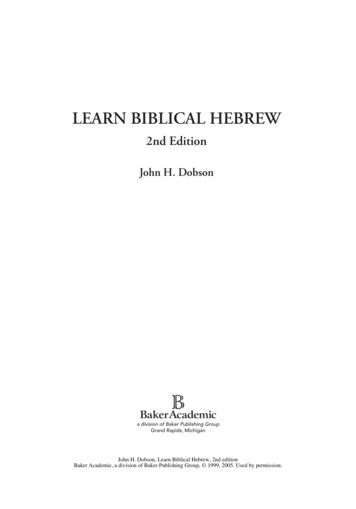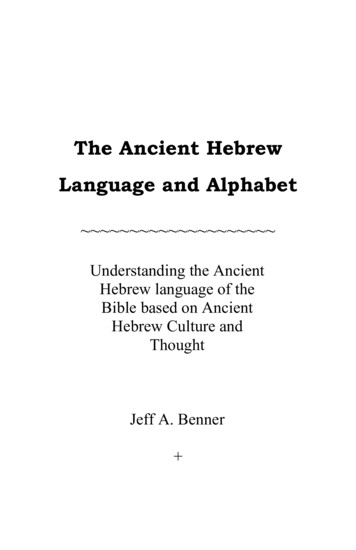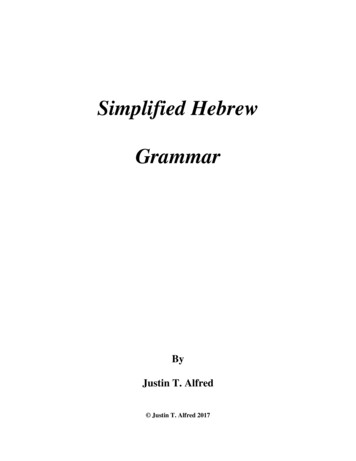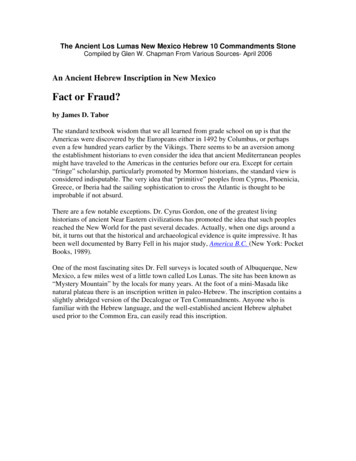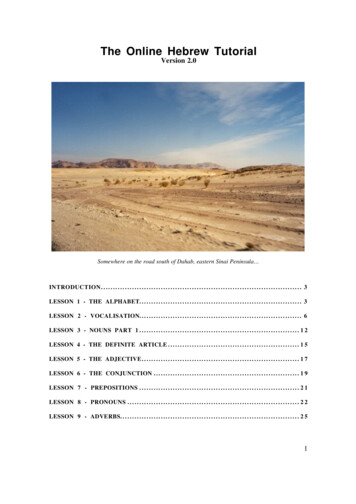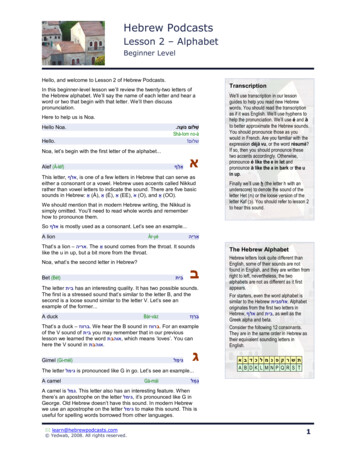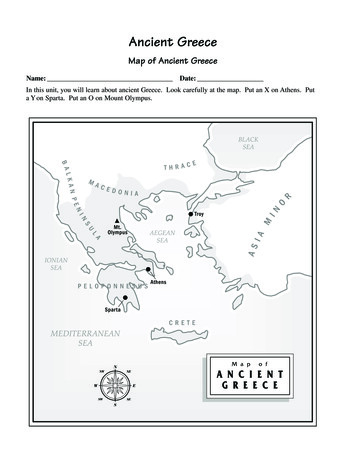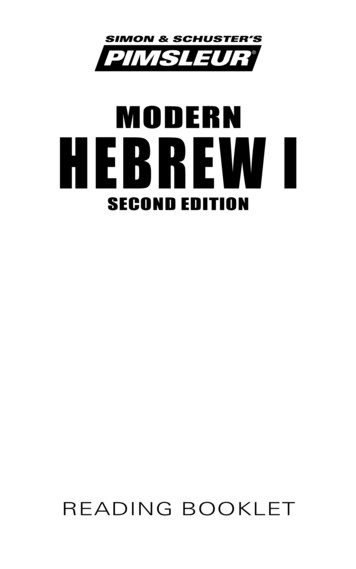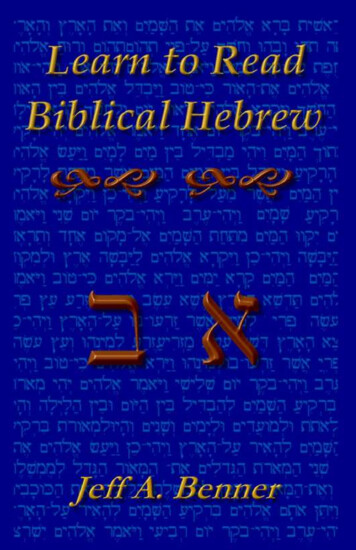
Transcription
Learn to ReadBiblical Hebrew
Learn to Read Biblical HebrewA guide to learning the Hebrewalphabet, vocabulary and sentencestructure of the Hebrew Bible By Jeff A. Benner
Cover design by Jeff A. Benner.“Learn to Read Biblical Hebrew,” by Jeff A. Benner.Published 2007 by Virtualbookworm.com Publishing Inc.,P.O. Box 9949, College Station, TX 77845, US. 2003,Jeff A. Benner. All rights reserved. Any part of this bookmay be copied for educational purposes only, withoutprior permission.Manufactured in the United States of America.
Learn to Read Biblical HebrewTable of ContentsINTRODUCTION .1THE ALEPHBET.5LESSONS .9LESSON 1 – ALEPH, BEYT . 9LESSON 2 – MEM, YUD . 11LESSON 3 – NUN, HEY. 13LESSON 4 – LAMED, VAV . 16LESSON 5 – RESH, SHIN . 19LESSON 6 – AYIN, TET . 23LESSON 7 – TAV, DALET. 26LESSON 8 – TSADE, QUPH . 30LESSON 9 – HHET, KAPH . 33LESSON 10 – ZAYIN, PEY . 36LESSON 11 – GIMEL, SAMEHH. 39READING PRACTICE . 42REFERENCE GUIDE . 51TRANSLATING LESSONS . 57LESSON 1 – GENESIS 1:1. 58LESSON 2 – GENESIS 1:2. 62LESSON 3 – GENESIS 1:3. 67LESSON 4 – GENESIS 1:4 & 5 . 70HEBREW / ENGLISH DICTIONARY . 71PARENT / CHILD ROOTS . 91ADOPTED ROOTS. 117vii
Learn to Read Biblical Hebrewviii
Learn to Read Biblical HebrewTo my Father who set me on thepath of Biblical studiesix
Learn to Read Biblical Hebrewx
Learn to Read Biblical HebrewIntroductionWhy Learn Hebrew?A translation of the Biblical text is a translator's“interpretation” of the text. The translator's beliefs willoften influence how the text will be translated and anyoneusing this translation will see it through the translator’seyes rather than that of the original authors. Only bystudying the original language of the Bible can one see andunderstand the text in its original state.Learning the Hebrew language can be both fun andexciting. By simply studying the pages that follow for justa few minutes a day you will soon be reading Hebrew,building a Hebrew vocabulary and even begin translatingBiblical passages for your self.About HebrewThe English word “alphabet” is derived from the first twoletters of the Greek Alphabet--Alpha and Beta. Hebrew onthe other hand, uses the word alephbet, the first twoletters of the Hebrew alephbet--Aleph and Beyt. TheHebrew alephbet consists of 22 consonants. The vowels(called nikkudot, nikkud in the singular) are dots anddashes added above and below the consonants. Oneadvantage to Hebrew is that the sound for each letterremains consistent, unlike English, where one has tomemorize many variations. For instance, the word “circus”1
Learn to Read Biblical Hebrewcontains the letter “c” twice, the first time it is pronouncedlike an “S” while the second time it is pronounced like a“K.” In Hebrew, the letter ( כּ kaph) is always pronouncedas a “K.”Unlike English, which is read from left to right, Hebrew isread from right to left, as are other Semitic languagesincluding Aramaic and Arabic. This may be difficult atfirst, but in a very short time, you will get used to it.When sounding out a word, it will be easier if youremember the Consonant (C) and Vowel (V) patterns ofHebrew words. In English, the consonants and vowelsmay be arranged in any order, such as in the word “circle,”which has a C V C C C V pattern. Hebrew on theother hand, is very consistent, and each word will usuallyfollow a C V C V C pattern. The Hebrew word מֶ לֶּך (melek - king) contains the pattern C V C V C, מֶ לֶכוֹ (meleko – his king) is C V C V C V and הָ מֶ לֶּך (hamelek – the king) is C V C V C V C.The pronunciations of some of the consonants and vowelshave changed over the centuries, but this does not affectthe meaning of words, as the letters of a word define it,and not the sounds. We will learn to pronounce themaccording to Modern Hebrew pronunciation. ModernHebrew pronunciation is also divided into two parts,Ashkenazi and Sephardic. Since Sephardic is thepronunciation adopted by the Modern State of Israel, wewill use this pronunciation.2
Learn to Read Biblical HebrewAbout this BookWhen I began to study the Hebrew language I used severaldifferent resources, but found that they were not compiledin a format easily understood by beginning Hebrewstudents. I began to arrange charts and lists containingnecessary information and compiled it into a readyresource for learning and reading the Hebrew Bible.This book is the result. Included in this book are lessonsfor learning the alephbet, verbs, nouns, adjectives andsentence structure.If at any time you have questions about the AncientHebrew Research Center, this book, its content or thelessons, please feel free to E-mail your questions orcomments to the website:http://www.ancient-hebrew.orgAdditional ResourcesIt should be kept in mind that this book is not meant to beused for in-depth Biblical study, but as a reference guidefor Biblical reading practice, vocabulary building andsentence comprehension. More specific dictionaries andlexicons will be necessary for more in-depth study.Through the process of Hebraic studies, you will want todig deeper into the meaning of specific words and phrases.At this point, the purchase of a Hebrew Bible and aHebrew Lexicon will be helpful. There are several differentkinds of Hebrew Bibles. The standard Hebrew Bible willbe a Bible written only in Hebrew. The Interlinear Bible3
Learn to Read Biblical Hebrewwill have the Hebrew on one line and the Englishtranslation for each word under each Hebrew word. AParallel Bible will have the Hebrew text on one page andthe English translation on the other.There are several different Lexicons, but be sure that theone you purchase includes all the words of the Bible withtheir prefixes and suffixes attached. This will allow you tolook up a word, even if you do not know the root. Irecommend Benjamin Davidson's Hebrew and ChaldeeLexicon of the Bible.4
Learn to Read Biblical HebrewThe AlephbetEach of the following eleven lessons introduces two newconsonants. They may or may not introduce new vowels.Each lesson will also include a practice section, newvocabulary words and sentences. The practice session willallow you to practice the new letters and vowels andrefresh your memory on previous ones. The vocabularysection will consist of a few words using the new lettersand vowels to begin building your Hebrew vocabulary.The sentences will allow you to begin using your newwords in sentences.To assist you in learning the letters and words, Irecommend that you put the letters and words you arelearning on flashcards. This will make it easy for you tostudy them at any time.Transliterations are included for the Hebrew in eachlesson. When reading these transliterations, remember touse the correct Hebrew sound for each vowel. Forexample, the transliterated Hebrew vowel sound “o” is thelong “o” sound as in the English word “rope.” So theHebrew transliteration “do” would be pronounced like theEnglish word “doe,” and not like the English word “do.”Alephbet and VowelsThe following is a chart of all the consonants in theHebrew Alephbet. This chart includes all the variations foreach letter. For example, the letter beyt can be written as ב 5
Learn to Read Biblical Hebrew(and has a “v” sound) or ( בּ and has a “b” sound). Five ofthe letters have a final form, a form of the letter that isdifferent when it appears at the end of a word, as well andare also included (such as מ , the normal form and ם , thefinal form).LamedMemNunSamehhAyinPeyTsadeQuphReshShinTav ל מם נן ס ע פפּף צץ ק ר שׂשׁ ת AlephBeytGimelDaletHeyVavZayinHhetTetYudKaph א בבּ ג ד ה ו ז ח ט י ככּך The VowelsBelow are the names for each of the Hebrew vowels.Hholam maleyQubbuts וֹ א QamatsPatahh1 א א In the following examples, the letter aleph ( )א is added only toshow the placement of the vowel and is not part of the vowel.16
Learn to Read Biblical HebrewShuruqHhataph qamatsHhataph patahhHhataph segol וּ א א א SegolTsereSh'vaHhireqHholam7 א א א א א
Learn to Read Biblical HebrewLetter ComparisonsSeveral of the Hebrew letters are very similar. In thebeginning, they are easily confused with other letters thatlook similar. Below is a chart showing letters of similarityin order to make the reader familiar with the yTav ב כ Dalet ב פ ג נ ה ח ה ת VavReshZayinVavF. NunZayinF. NunHhetTav8 ד ר Kaph ו ז ו ן ז ן ח ת MemPeyTetF. MemSamehhSamehhTetAyinTsade כ פ מ ט ם ס ס ט ע צ
Learn to Read Biblical HebrewLessonsLesson 1 – aleph, beytConsonants א ב The “Aleph” is the first letter of the Hebrewalephbet. This consonant is silent.The “Beyt” is pronounced one of two ways, “b” asin “ball” or “v” as in “visit.” When a dagesh (a dotin the middle of the letter) appears in the middle ofthe letter ( )בּ it will have the “b” sound. When theletter appears without the dagesh ( )ב , the letter ispronounced “v.”Vowels א This vowel, called a “qamats,” (the little “T”shaped mark under the aleph) is pronounced “a” asin “father.” א This vowel, called a “patahh,” is also pronounced“a” as in “father.”9
Learn to Read Biblical HebrewPractice בּאבבּאאבּאאב בא בּא אב בּא אב בּא 1.2.Practice (transliteration)1. 2 ba a va ba a a ba a a va2. va ba av ba av baVocabulary1. אב avFather32. בָּ א baCame (m.)4Sentences1.5 אב בּא׃ av baFather came.2While Hebrew is written from right-to-left, transliterations usingthe Roman alphabet are written left-to-right.3Each Hebrew noun is either masculine or feminine (there is noneuter gender in Hebrew). In some cases the gender is obvious, suchas “father” and “mother.”4Most Hebrew verbs, when conjugated, are either masculine orfeminine.5The “ ”׃ is a Hebrew period (.).10
Learn to Read Biblical HebrewLesson 2 – Mem, YudConsonants מ ם י The “Mem” is pronounced “m” as in “mother.”The “final Mem” is used only when it appears at theend of a word. The pronunciation does not change.The “Yud” is pronounced “y” as in “yes.” (Whenthe “yud” is suffixed to a word it means “of me” or“my.” Sentence #2 includes the word אב ָ - father,with the suffix י it forms the word אבי - myfather.)Vowels א א The “hhireq” is pronounced “i” (ee) as in“machine.”The “tsere” is pronounced “ey” as in “grey.”Practice1.2. בבּבבּאאממםמ אי אי בי בּי מי אם אם 11
Learn to Read Biblical HebrewPractice (transliteration)1. vi6 bey vey bi ey i mi mey ma ma72. ey iy viy biy miy eym imVocabulary1. אם eymMother2. מי miyWhoSentences1.? מי בּא miy ba?Who came?2. אבי בּא׃ aviy ba.My father came.6This is pronounced “vee.”The hhireq vowel has an “ee” sound and the letter yud has a “y”sound, but when this vowel and letter are combined, they still havethe “ee” sound.712
Learn to Read Biblical HebrewLesson 3 – Nun, HeyConsonants נ ן ה The “Nun” is pronounced “n” as in “no.”The “final Nun” is only used when it appears at theend of a word. The pronunciation does not change.The “Hey” is pronounced “h” as in “hello.” (Whenthe letter ה is prefixed to a word it means “the”such as in sentence #6 where the letter ה isprefixed to the word נביא - prophet, forming הנביא - the prophet.)Practice1.2.3. ה ה ה נ נ ני בּן בּה הב הן הן נה נה נה נב מה מן נא הי נא ני היא ניא נבה בּנה Practice (transliteration)1. ha hi hey na ney ney beyn bah hav2. han heyn nah nih neyh nav mah min na3. hiy na ney hiy niy na-vah ba-nah13
Learn to Read Biblical HebrewVocabulary1. אי eyWhere2. אני aniyI3. היא hiyShe4. בּן beynSon5. בּאה ba'ahCame (f.)6. נביא na-viyProphet (m.)7. מה or מה mahWhat?Sentences מי היא 1.miy hiyWho [is]8 she? אני אב 2.aniy avI [am a]9 father.8The English verb “to be” and its various tenses (am, is, are, etc.) donot exist in Hebrew and need to be added in the translation.14
Learn to Read Biblical Hebrew בּני בּא 3.bey-niy baMy son came.4. אי אבי ey a-viyWhere [is] my father?5. מה נביא mah na-viyWhat [is a] prophet?6. הנביא בּא ha-na-viy baThe prophet came.9English has two indefinite articles, “a” and “an,” which also do notexist in Hebrew and must be added in the translation.15
Learn to Read Biblical HebrewLesson 4 – Lamed, VavConsonants ל ו The “Lamed” is pronounced “l” as in “long.”The “Vav” is pronounced “v” as in “visit.”Vowels א The “sh'va” is pronounced “eh” as in “help” when itis placed under the first letter of the word. Whenthis vowel appears anywhere else in the word, it isusually a “syllable break” and not pronounced. א The “segol” is pronounced “eh” as in “help.”Practice1.2.3. לי וי וי ל ל לֶ ל ל ו וָ וי לי לי וו ָוו ֶלל ול ול ול לה הל לה הל ָווים לבּה ליל לבמה מלא 16
Learn to Read Biblical HebrewPractice (transliteration)1. lai10 vai vey ley la le li la ve va viy lai liy2. vev vav lel vel veyl val leyh heyl lah hal3. va-viym li-bah la-yil leyv-mah ma-leyVocabulary1. לילה lai-lahNight (m.)2. אל eylGod (m.)3. מים ma-yimWater (m.)4. אמן a-meynAmen5. הנה hin-neyhHere116. ים yamSea (m.)10When one of the “a” vowels (qamats or patahh) is followed by theconsonant “yud” in the same syllable, the pronunciation is a long “i”as in “lie” and NOT “ay” as in “lay.”11When the dagesh (the dot in the middle of a letter) is placedwithin some letters, such as in the nun in the word הנה , it doublesthe letter. Therefore, this word is pronounced “hin-ney” rather than“hi-ney.”17
Learn to Read Biblical HebrewSentences לילה בּא 1.lai-lah baNight came. בּים 12 מים 2.ma-yim ba-yamWater [is] in [the] sea.3. לי 13 בּני בּא bey-niy ba liyMy son came to me.4. אם בּאה בּלילה eym ba-ah ba-lai-lahMother came in the night.5. ואמי הנה 14 אבי a-viy v-ey-miy hin-neyhMy father and my mother [are] here.12When the letter “beyt” is prefixed to a word it means “in,” so thisword means “in [the] sea.”13When the letter “lamed” is used as a prefix it means “to” or “for.”This prefix is followed by the י suffix meaning “me,” so this means“to me” or “for me.”14When the letter “vav” is prefixed to a word it means “and.”18
Learn to Read Biblical HebrewLesson 5 – Resh, ShinConsonants ר ש The “Resh” is pronounced “r” as in “rain.”The “Shin” is pronounced one of two ways, “sh,”as in “sharp” or “s,” as in “sign.” When a dot isplaced on the top right corner of the letter ( )שׁ ittakes the “sh” sound and when the dot is placed onthe top left corner of the letter ( )שׂ it takes the “s”sound.Vowels וֹ This combination of the vav (consonant) and thehholam (vowel) is called a “hholam maley” and ispronounced “o” as in “open.”Practice1.2.3. שׁ שׁ שׂ ר ר רי שׁי שׂי רוֹ שׁוֹ שׂוֹ שׁשׁ שׂר שׁיר שׁוֹר שׂר רשׁ רוֹשׁ נר יר רב משׁ שׂב שׂים השׁ שׁל 19
Learn to Read Biblical HebrewPractice (transliteration)1. she15 sha sey rey ri rai shey sey ro sho so2. sheysh sar shiyr shor sir rash rosh3. neyr yar rav mish sav siym hesh shelVocabulary1. שׁלוֹם sha-lomPeace (m.)2. שׁמים sha-ma-yimHeaven (m.)3. אמר a-marSaid (m.)4. בּרא ba-raCreated (m.)5. שׁם sheymName (m.)6. אמרה am-rahSaid (f.)7. שׂר sarRuler (m.)8. יוֹם yomDay (m.)9. אוֹר orLight (m.)15Remember, this is not the English word “she,” but a Hebrew word,and the “e” is pronounced with a short “e” and not a long “e” as it isin the English word “she.”20
Learn to Read Biblical Hebrew10. רבּי rab-biyRabbi (m.)Sentences1.16 שׂר שׁלוֹם sar sha-lomRuler of Peace. יוֹם ולילה 2.yom v-lai-lahDay and night.3. שׁמי לוי sh-miy ley-viyMy name [is] Levi.4. שׁמוֹ 17 מה mah sh-moWhat [is] his name?5. שׁמוֹ אברהם sh-mo av-ra-hamHis name [is] Abraham.6. אל שׁמים 18 בּרא ba-ra eyl sha-ma-yimGod created heaven.16This phrase can be found in Isaiah 9:6 (5 in Hebrew Bibles).When the consonant/vowel combination “hholam maley” issuffixed to a word it means “of him” or “his.”18In Hebrew, the verb usually appears before the object of the verb.1721
Learn to Read Biblical Hebrew7. אמר רבּי לי שׁלוֹם a-mar rab-biy liy sha-lomRabbi said to me, Shalom.22
Learn to Read Biblical HebrewLesson 6 – Ayin, TetConsonants ע ט The “Ayin” is silent (the same as the aleph).The “Tet” is pronounced “t” as in “tune.”Vowels וּ This consonant (vav) / vowel combination is calleda “shuruq” and is pronounced “u,” as in “tune.”Practice1.2.3. ע ט ע ט ע אט טוּ טא עא עט הוֹ הוּ אוֹ אוּ בּוֹ בּוּ לוֹ לוּ וֹן וּן ֶרט שׂט בּע בט טוּב טוּע עוּט Practice (transliteration)1. e te ey ti i et tu te e et2. ho hu o u bo bu lo lu on un3. ret set be vet tuv tu ut23
Learn to Read Biblical HebrewVocabulary1. טוֹב tovGood (m.)2. ערב e-revEvening (m.)3. על alOver, on4. ישׂראל yis-ra-eylIsrael5. הוּא huHe6. היא hiyShe7. שׁוֹמר sho-meyrKeep (m.)Sentences טוֹב 19 ערב 1.e-rev tovGood evening. שׁמם 20 מה 2.mah sh-mam19In Hebrew, the adjective follows the noun, such as the word טוֹב (good) which comes after ( ערב evening).20When the letter “Mem” is suffixed to a noun it means “of them” or“their.”24
Learn to Read Biblical HebrewWhat is their name?3. שׁמוּ ישׂראל sh-mu yis-ra-eylTheir name is Israel.4. שׁלוֹם על ישׂראל sha-lom al yis-ra-eylPeace over Israel.5. מי בּא בּערב miy ba ba-e-revWho came in the evening?6. הוּא בּא בּערב hu ba ba-e-revHe came in the evening.7. היא בּאה בּערב hiy ba-ah ba-e-revShe came in the evening.25
Learn to Read Biblical HebrewLesson 7 – Tav, DaletConsonants ת ד The “Tav” is pronounced “t” as in “tune.”The “Dalet” is pronounced “d” as in “dig.”Vowels א This vowel combination (sh'va and segol) is called a“hhataph segol” and is pronounced “eh” as in“help.” א The “hholam” is pronounced “o” as in “open.”Practice1.2.3. ד ד ד ד ד ד ד דוֹ ת ת ת ת ת ָדת דת דת דוֹת תד תד דת דד תוֹד בית ָדב אל מת תן מיד Practice (transliteration)1. de da de dey di da do do te te tey ti ta26
Learn to Read Biblical Hebrew2. dat det dot dot tod ted deyt dad3. tod veyt dav el mot tan miydVocabulary1. אֹלהים e-lo-hiymGod (m.)2. משׁה 21mo-shehMoses3. נתן na-tanGave (m.)4. את 22et(With)5. תוֹרה 23to-rahTeaching (f.)21Remembering the C V C V rule, the Hebrew word for Moses, משׁה , appears to be missing a vowel after the mem. Since Hebrewrequires a vowel after each consonant, the vowel is the hholam and isplaced above the letter shin in the same place as the dot above theright leg of the shin. The dot in this case serves two purposes.22The Hebrew word את is occasionally used in the text to mean“with” but is more frequently used (about 7,000 times) as markersfor the definite object of the verb and is untranslatable into English.For example, in the sentence; “I made the dinner”; the phrase “thedinner” is the definite object and would be preceded by the word את .If the sentence were; “I made a dinner,” את would not precede itsince “dinner” in this sentence is not a definite object.23The word תוֹרה , while often translated as “law,” actually means“teaching” and is also the Hebrew name for the first five books of theBible as they contain the “teachings” of God.27
Learn to Read Biblical Hebrew6. שׁבּת shab-batSabbath (m.)7. תלמיד tal-miydStudent (m.)8. תלמידה 9. לוֹמד 10. לוֹמדת 11. ראשׁית 24tal-miy-dah Student (f.)lo-meydStudies (m.)lo-me-detStudies (f.)rey-shiytBeginning (f.)Sentences שׁבּת שׁלוֹם 1.shab-bat sha-lomPeaceful Sabbath. ושׁמרוּ את השׁבּת 2.v-sham-ru et ha-shab-batAnd they will keep the Sabbath.3. בּראשׁית בּרא אֹלהים b-rey-shiyt ba-ra e-lo-hiymIn the beginning God created.4. תלמידה לוֹמדת תוֹרה 24An exception to the rule requiring the C V C V pattern is theword ראשׁית . The aleph does not always require a vowel after it.28
Learn to Read Biblical Hebrewtal-miy-dah lo-me-det to-rahA student studies Torah.5. לנוּ משׁה את התוֹרה 25 נתן na-tan la-nu mo-sheh et ha-to-rahMoses gave to us the Torah.6. תלמיד לוֹמד את התוֹרה tal-miyd lo-meyd et ha-to-rahA student studies the Torah.25When the letter “lamed” is used as a prefix it means “to” or “for.”The suffix נוּ means “us.” Combined, this prefix and suffix mean “tous” or “for us.”29
Learn to Read Biblical HebrewLesson 8 – Tsade, QuphConsonants צ ץ The “Tsade” is pronounced “ts” as in “pots.” ק The “Quph” is pronounced “q” as in “quiet.”The “final Tsade” is used when this letter appears atthe end of a word. The pronunciation does notchange.Vowels א This vowel combination (sh'va and patahh) is calleda “hhataph patahh” and is pronounced “a” as in“father.”Practice1.2.3. צצצצקקקקקק אץ קץ צק צק קץ רק רץ צץ צא צה קא קה קץ הץ 30
Learn to Read Biblical HebrewPractice (transliteration)1. tsi tso tsa tse qi qo qa qe qa qey2. ots qeyts tsaq tsiq qots raq rets3. tsits tse tsoh qa qah qots hotsVocabulary1. היה ha-yahExisted (m.)2. ארץ e-retsLand (f.)SentencesGenesis 1:1426 ויאמר אֹלהים יהי מארת בּרקיע השמים להבדיל בּין היוֹם וּבין הלילה והיוּ לאתת וּלמוֹעדים וּלימים ושׁנים 26From this point on, the alephbet lessons will include Biblicalpassages. While most of the words will not be recognizable at thistime, remember that our objective is to “read” the text, notnecessarily understand it.31
Learn to Read Biblical HebrewSentences (transliteration)vai-yo-mer e-lo-him ye-hi me-o-rot bir-qi-a hasha-ma-yim le-hav-dil beyn hai-yom u-veyn halai-lah ve-hai-u le-o-tot ul-mo-a-dim ul-ya-mimve-sha-nim32
Learn to Read Biblical HebrewLesson 9 – Hhet, KaphConsonants ח כ The “Hhet” is pronounced “hh” as in the Germanword “ich” or the name “Bach.” ך The “final kaph” may also appear with the dagesh( )ּך or without the dagesh ( )ך , with thepronunciations being the same as the “kaph.” Allwords will end with a consonant; the only exceptionto this is the “final kaph” which will usually befollowed by a vowel.The “Kaph” is pronounced one of two ways, “k” asin kick or “kh” as in the German word “ich” or thename “Bach.” If the dagesh appears in the middleof the letter ( )כּ it is pronounced “k.” When thedagesh does not appear in the letter ( )כ it ispronounced “kh.”Vowels א The “qubbuts” is pronounced “u” as in “tune.”Practice1. כככּכּכחחחחחח 33
Learn to Read Biblical Hebrew2.3. כח חָך חּך כּח חָך 27 הְך כּח רח רח רָך אְך חְך חָך אח Practice (transliteration)1. khi khe key ko khu hha hhe hhey hhi hho hhu2. hakh ko-ahh khahh hhey-kha hheyk kihh hhikha3. ro-ahh ru-ahh ra-kha akh hhakh hha-kha ahhVocabulary1. כן kheynYes, so2. עשׂב e-sevGrass, herb (m.)3. עץ eytsTree (m.)SentencesGenesis 1:527When the letter hhet is at the end of a word and has one of the “a”vowels (the patahh or qamats), the order in which these letters ispronounced is reversed. In this case, this word is pronounced ko’ahh,not ko’hha.34
Learn to Read Biblical Hebrew וי ְק ָרא אֹלהים לָאוֹר יוֹם וְ לחשֶ ְך ב ֶקר - עֶ ֶרב ויְהי 28- ָק ָרא ָל ְילָה ויְהי יוֹם ֶא ָחד׃ Sentences (transliteration)vai-yiq-ra e-lo-him la-or yom ve-la-hho-shekh qara lai-lah vai-hi e-rev vai-hi vo-qer yom e-hhad28This “hyphen,” called a maqeph, connects words together and theyare pronounced as one word.35
Learn to Read Biblical HebrewLesson 10 – Zayin, PeyConsonants ז פ The “Zayin” is pronounced “z” as in “zoo.” ף The “final Pey” is only used when this letter appearsat the end of a word. The “final pey” will neverappear with the dagesh and will therefore bepronounced “ph.”The “Pey” is pronounced one of two ways, “p” asin “pad” or “ph” as “phone.” If the dagesh appearsin the middle of the letter ( )פּ it is pronounced “p.”When the dagesh does not appear in the letter ( )פ itis pronounced “ph.”Vowels א This vowel combination (sh'va and qamats) iscalled a “hhataph qamats” and is pronounced “a”as in “father.”Practice1.2. פ פ פ פּ ז ז ז ז זוֹ פּוֹ פי זה זא אף אז הז זא פז זף 36
Learn to Read Biblical Hebrew פּח פּן שׁז שׁז כּף זְך קף 3.Practice (transliteration)1. phe pha phe pey zu zey za zi zo po phiy2. zah zey aph eyz hez ze phaz zeph3. po-ahh pan shaz shaz kaph zeykh quphVocabulary1. אשׁר a-sherWhich, who2. עשֶׂ ה o-sehMaking (m.)3. פּנים pa-niymFace (m.)SentencesGenesis 1:11 ויאמר אֹלהים תדשׁא הארץ דשׁא עשׂב מזריע זרע עץ פּרי עשׂה פּרי למינוֹ אשׁר זרעוֹ בוֹ על הארץ ויהי כן 37
Learn to Read Biblical HebrewSentences (transliteration)vai-yo-mer e-lo-him tad-shey ha-a-rets de-she eysev maz-ri-a ze-ra eyts pe-ri o-seh pe-ri le-mi-noa-sher zar-o vo al ha-a-rets vai-hi kheyn38
Learn to Read Biblical HebrewLesson 11 – Gimel, SamehhConsonants ג ס The “Gimel” is pronounced “g” as in “game.”The “Samehh” is pronounced “s” as in “sand.”Practice1.2.3. סססססגגגגגגג סם אס סה גוֹא אג גא גה מס סס סף סג גס סר סד Practice (transliteration)1. so su sa sey si ge ga ga ge go gi ga2. sem as seyh go ag ge goh3. mas seys seyph seyg gas sur sod39
Learn to Read Biblical HebrewVocabulary1. כּל 292. אדם 3.4.kolAlla-damMan עוֹף ophBird (m.) דגה da-gahFish (f.)SentencesGenesis 1:26 ויאמר אֹלהים נעשׂה אדם בּצלמנוּ כּדמוּתנוּ וירדוּ בדגת הים וּבעוֹף השמים וּבבּהמה וּבכל הארץ וּבכל הרמשׂ הרמשׂ על הארץ 29This word appears to be pronounced “kal” but, is actuallypronounced “kol.” In this instance the qamats vowel represents arare vowel pronounced “o.”40
Learn to Read Biblical HebrewSentences (transliteration)vai-yo-mer e-lo-him na-a-seh a-dam be-tsal-meynu kid-mu-tey-nu ve-yir-du vid-gat hai-yam uvoph ha-sha-ma-yim u-va-be-hey-mah uv-khol haa-rets uv-khol ha-re-mes ha-ro-meys al ha-a-rets41
Learn to Read Biblical HebrewReading PracticeBelow is the first chapter of the book of Genesis inHebrew. The name “Genesis” comes from the Greek namefor this book and means “origins.” The Hebrew name forthis book is “Bereshiyt.” The Hebrew names for the firstfive books of the Bible are derived from the first word (orfirst principle word) of the book. In this case, the firstword in the book is “bereshiyt,” which means “in thebeginning.”The purpose of this section is to allow you to practicereading. Also included is a transliteration of the chapter forpronunciation help. Again, remember to use the correctHebrew pronunciation for each vowel.42
Learn to Read Biblical Hebrew &בְּ ראשית בָּ ָרא אֹלהים את השָ מים 1 וְ את הָ ָא ֶרץ׃ be-rey-shit ba-ra e-lo-him eyt ha-sha-ma-yim veeyt ha-a-rets פְ ני - &וְ הָ ָא ֶרץ הָ י ְָתה תהּו וָבהּו וְ חשֶ ְך על 2 פְ ני - ְתהוֹם וְ רּוח אֹלהים ְמרחֶ פֶת על המָ ים׃ ve-ha-a-rets hai-tah to-hu va-vo-hu ve-hho-shekhal pe-ney te-hom ve-ru-ahh e-lo-him me-ra-hhephet al pe-ney ha-ma-yim אוֹר׃ - &ויאמֶ ר אֹלהים יְהי אוֹר ויְהי 3vai-yo-mer e-lo-him ye-hi or vai-hi or טוֹב ויבְ דל - הָ אוֹר כּי - &וי ְרא אֹלהים ֶאת 4 אֹלהים בּין הָ אוֹר ּובין החשֶ ְך׃ vai-yar e-lo-him et ha-or ki tov vai-yav-deyl e-lohim beyn ha-or u-veyn ha-hho-shekh &וי ְק ָרא אֹלהים לָאוֹר יוֹם וְ לחשֶ ְך ָק ָרא 5 ב ֶקר יוֹם ֶאחָ ד׃ - עֶ ֶרב ויְהי - ָל ְילָה ויְהי vai-yiq-ra e-lo-him la-or yom ve-la-hho-shekh qara lai-lah vai-hi e-rev vai-hi vo-qer yom e-hhad43
Learn to Read Biblical Hebrew &ויאמֶ ר אֹלהים יְהי ָרקיע בְּ תוְֹך המָ ים 6 ויהי מבְ דיל בּין מים לָמָ ים׃ vai-yo-mer e-lo-him ye-hi ra-qi-a be-tokh ha-mayim vi-hi mav-dil beyn ma-yim la-ma-yim הָ ָרקיע ויבְ דל בּין - &ויעשׂ אֹלהים ֶאת 7 המים אֲ שֶ ר מתחת ל ָָרקיע ּובין המים כן׃ - אֲ שֶ ר מעל ל ָָרקיע ויְהי vai-ya-as e-lo-him et ha-ra-qi-a vai-yav-deyl beynha-ma-yim a-sher mi-ta-hhat la-ra-qi-a u-veynha-ma-yim a-sher mey-al la-ra-qi-a vai-hi kheyn- &וי ְק ָרא אֹלהים ל ָָרקיע שָ מָ ים ויְהי 8 ב ֶקר יוֹם שני׃ - עֶ ֶרב ויְהי vai-yiq-ra e-lo-him la-ra-qi-a sha-ma-yim vai-hie-rev vai-hi vo-qer yom shey-ni &ויאמֶ ר אֹלהים י ָקוּו המים מתחת 9 מָ קוֹם ֶאחָ ד וְ ת ָר ֶאה היבָּ שָ ה - השָ מים ֶאל כן׃ - ויְהי vai-yo-mer e-lo-him yi-qav-u ha-ma-yim mi-tahhat ha-sha-ma-yim el ma-qom e-hhad ve-tey-raeh hai-ya-ba-shah vai-hi kheyn &וי ְק ָרא אֹלהים ליבָּ שָ ה ֶא ֶרץ ּולְמ ְקוה 11 טוֹב׃ - המים ָק ָרא ימים וי ְרא אֹלהים כּי 44
Learn to Read Biblical Hebrewvai-yiq-ra e-lo-him lai-ya-ba-shah e-rets ul-miqveh ha-ma-yim qa-ra ya-mim vai-yar e-lo-him kitov &ויאמֶ ר אֹלהים ת ְדשא הָ ָא ֶרץ דֶ שֶ א 11 עשֶׂ ב מזְ ריע זֶרע עץ פְ רי עשֶׂ ה פְ רי לְמינוֹ כן׃ - הָ ָא ֶרץ ויְהי - בוֹ על - אֲ שֶ ר ז ְרעוֹ vai-yo-mer e-lo-him tad-shey ha-a-rets de-she eysev maz-ri-a ze-ra eyts pe-ri o-seh pe-ri le-mi-noa-sher zar-o vo al ha-a-rets vai-hi kheyn &ותוֹצא הָ ָא ֶרץ דֶ שֶ א עשֶׂ ב מזְ ריע זֶרע 12 בוֹ - פְ רי אֲ שֶ ר ז ְרעוֹ - לְמינהּו וְ עץ עשֶׂ ה טוֹב׃ - לְמינהּו וי ְרא אֹלהים כּי va-to-tsey ha-a-rets de-she ey-sev maz-ri-a ze-rale-mi-ney-hu ve-eyts o-seh pe-ri a-sher zar-o vole-mi-ney-hu vai-yar e-lo-him ki tov ב ֶקר יוֹם ְשלישי׃ - עֶ ֶרב ויְהי - &ויְהי 13vai-hi e-rev vai-hi vo-qer yom she-li-shi &ויאמֶ ר אֹלהים יְהי ְמארת בּ ְרקיע 14 השָ מים לְהבְ דיל בּין היוֹם ּובין ה ָל ְילָה וְ הָ יּו לְאתת ּולְמוֹעֲדים ּו ְליָמים וְ שָ נים׃ vai-yo-mer e-lo-him ye-hi me-o-rot bir-qi-a hasha-ma-yim le-hav-dil beyn hai-yom u-veyn ha45
Learn to Read Biblical Hebrewlai-lah ve-hai-u le-o-tot ul-mo-a-dim ul-ya-mimve-sha-nim &וְ הָ יּו ל ְמאוֹרת בּ ְרקיע השָ מים לְהָ איר 15 כן׃ - הָ ָא ֶרץ ויְהי - על ve-hai-u l
Learn to Read Biblical Hebrew A guide to learning the Hebrew alphabet, vocabulary and sentence structure of the Hebrew Bible By Jeff A. Benner . Cover design by Jeff A. Benner. . At this point, the purchase of a Hebrew Bible and a Hebrew Lexicon will be helpful. There are several different kinds of Hebrew

